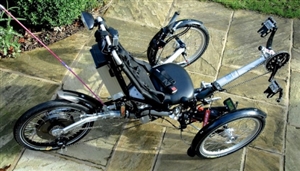In early 2014 I started the design of a proof of concept e-Trike that could be used for the rehabilitation of a wheelchair user with cerebral palsy (CP). This was to be a personal project where I could use my engineering knowledge and skills to improve the quality of life for wheelchair users facing rehabilitation. The aim was to create more than an electric bike – it was to create a computer controlled electrically assisted e-Trike that would enable the wheelchair user to benefit from the many physical and mental aspects of assisted mobility.
The e-Trike would encourage mobility and independence as well as the development of spatial awareness and muscle strengthening. It would also improve balance and increase tolerance to exercise for the user. Information from trials would be recorded electronically to provide evidence of increasing fitness and resilience, while correlating performance data with accurate geolocation data. Key to the viability of this project was the discovery of an affordable torque sensing ‘bottom bracket’ manufactured by a German company and an innovative cycling computer developed in Canada.
Dr Peter Bannister, IET Healthcare Technologies Network Executive Committee, heard about my project and together with Prof Chris Nugent Professor of Biomedical Engineering at the University of Ulster, asked me if I would be prepared to talk about the e-Trike at a forthcoming conference. The talk was to be given at the 8th International Conference on Ubiquitous Computing and Artificial Intelligence (UCAmI) and the 6th International Work-Conference on Ambient Assisted Living and Daily Activities (IWAAL) in Belfast, from 2-5 December 2014. In the spring of 2014, December seemed a long way off, so I readily agreed.
By June/July 2014 I had the prototype running and informed Chris and Peter about the e-Trike’s good progress. My enthusiasm for the project was matched by Peter and Chris’ eagerness for me to not only talk about the e-Trike, but to also demonstrate it during the December IWALL conference in Belfast. Although the logistics of transporting a prototype e-Trike to Belfast were fairly significant, I readily agreed. It was not long before December 1st arrived and I was leaving London with the e-Trike folded up in the boot of the family car, driving non-stop to Holyhead to catch the ferry to Dublin. Later that same day I arrived at the Europa Hotel, Belfast, infamous for having been bombed some 37 times during the time of the troubles.
I had allowed 2 hours to reassemble the e-Trike in the Assembly Halls the next morning, but within 30 minutes the e-Trike was up and quite literally running across the floor of the central hall. This gave me an unexpected opportunity to discuss the design with a number of well-informed students and delegates. Later that day the Deputy Mayor of Belfast welcomed conference delegates during a reception held in Belfast’s magnificent City Hall.
It was a privilege to be in the historic capital of Northern Ireland – a country that had produced many famous engineers, scientists and politicians. Following the Good Friday Agreement of 1998, the city of Belfast has become a stimulating and lively hub of all manner of commerce and culture. Everyone I met both on the streets and those attending the conference apperaed to radiate optimism, enthusiasm and energy.
Delegates to the conference were truly international, many of whom had travelled from Norway, the Netherlands, Pakistan, Canada, Spain, Argentina, Chile, Mexico and Columbia. All were united by their passion in applying engineering and computing skills to improve the quality of life for people less fortunate than themselves. There were many inspirational speakers including engineering PhD students from the University of Ulster who described how computing was increasingly making a positive difference to the lives of others. Collaboration was the key to success and for these 4 days it felt like a true engineering renaissance had begun in Belfast.
The highlight of the social events was the Gala Dinner held in the Titanic Centre towards the end of the conference. The Titanic Centre is a superb visitor attraction, located on the very slipways where Titanic was built at the heart of Belfast. This is an awe-inspiring experience that justifiably demonstrates the engineering heritage of Belfast
The one criticism I have of the conference is that there were so many parallel presentations it was impossible to attend all sessions of interest, particularly when demonstrating in the exhibition hall. Nonetheless the value of networking and hopefully collaborating with such an international gathering of engineers and scientists was immense. I left the conference both inspired and encouraged to collect experimental data from e-Trike trials during 2015.
NB.
Example PowerPoint slides from my presentation entitled “Mobile computing and the e-Trike – how ubiquitous computing is creating new rehabilitation opportunities for wheelchair users” are available to view in the files area. GoPro video footage is also available to view in the video area.
Chairman of the IT charities AbilityNet and UCanDoIT
31st January 2015
